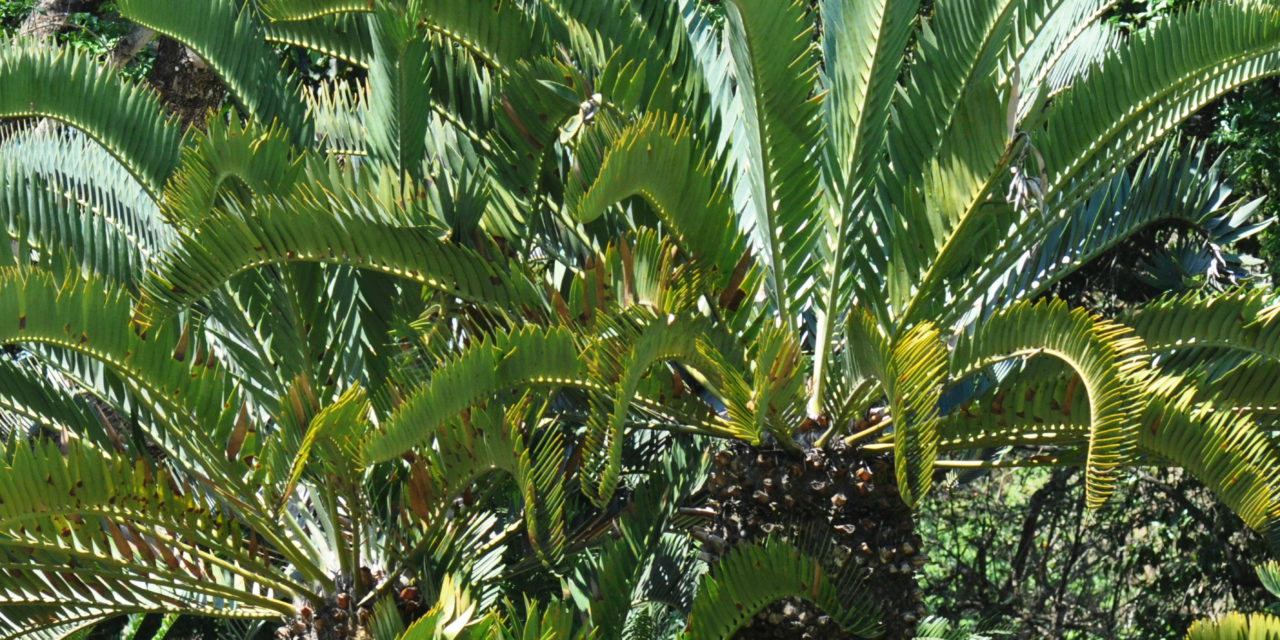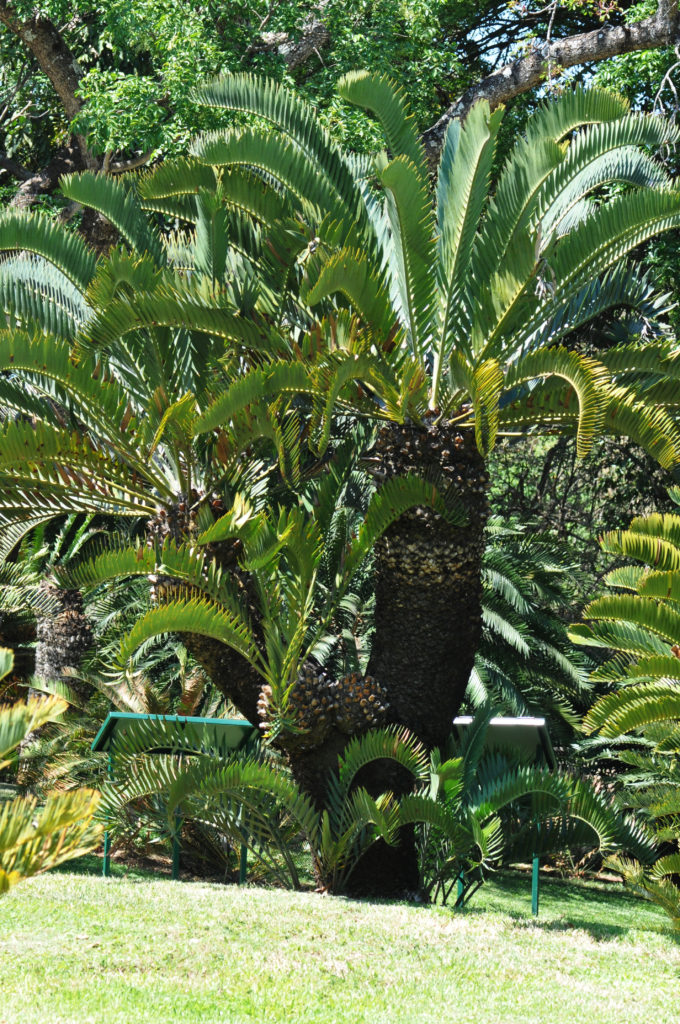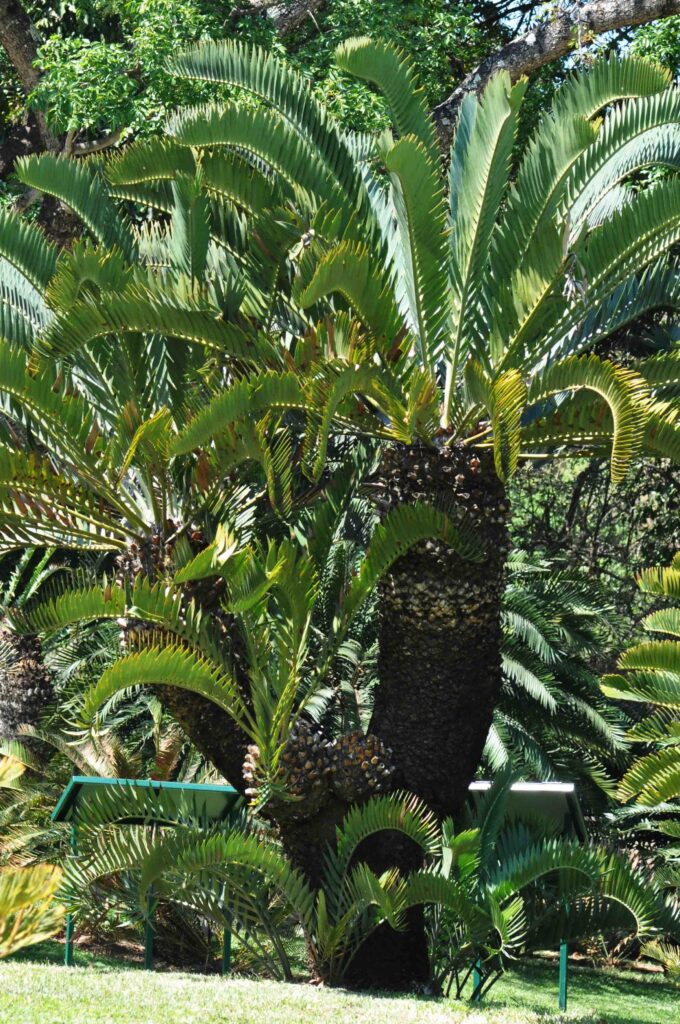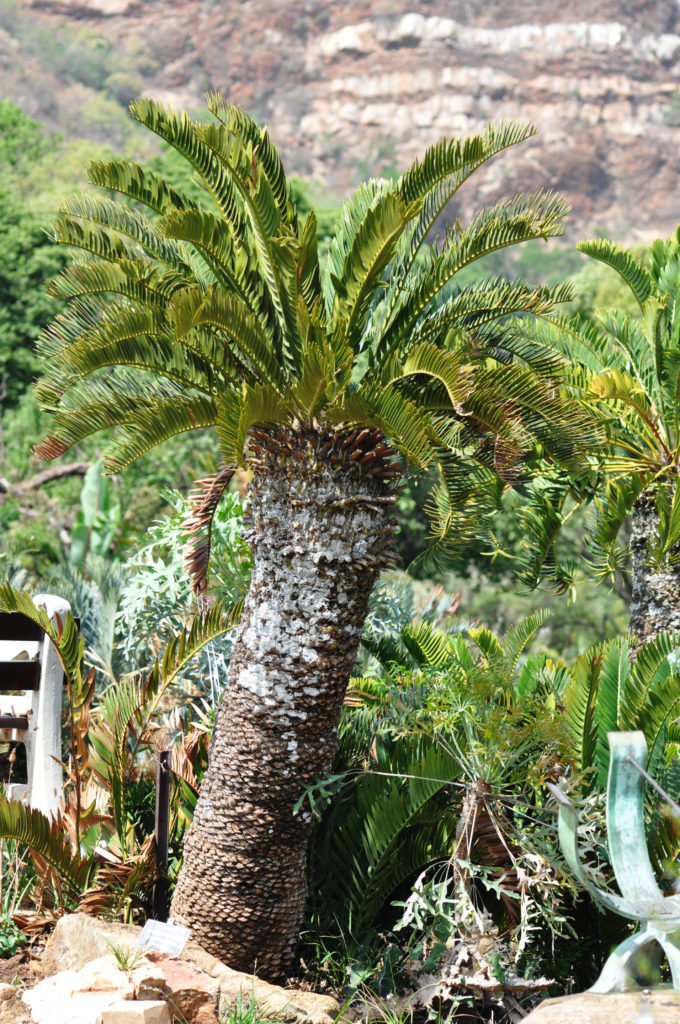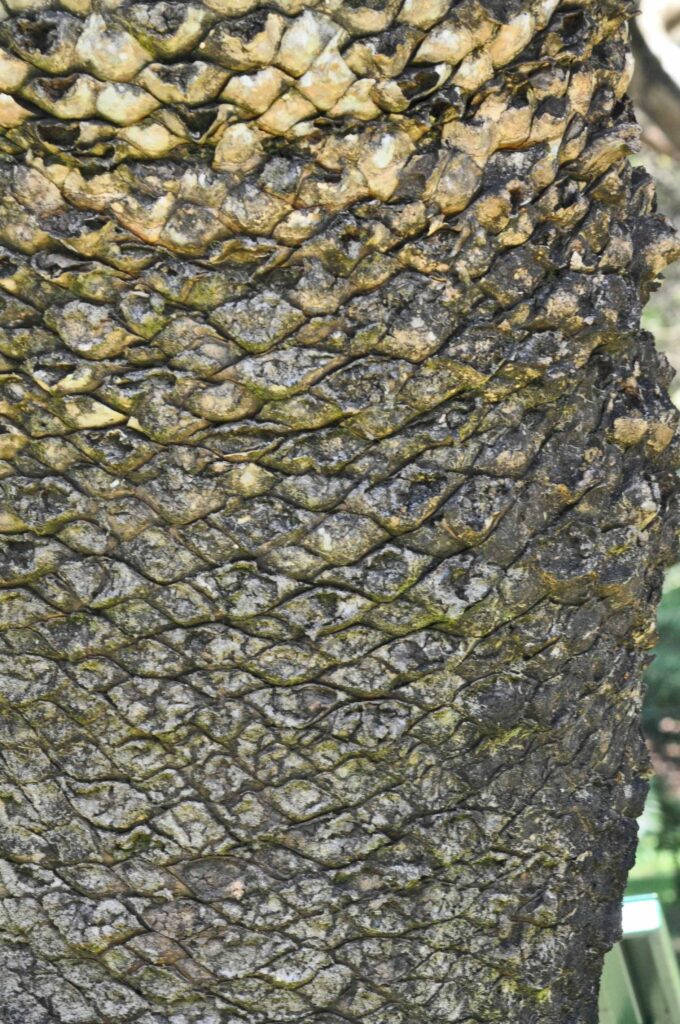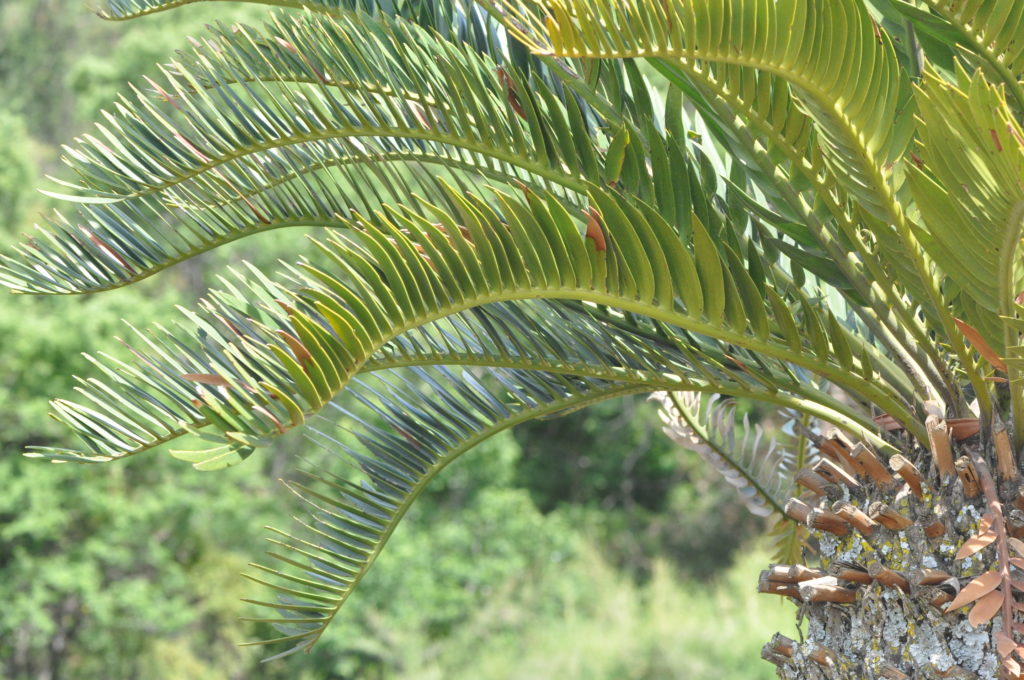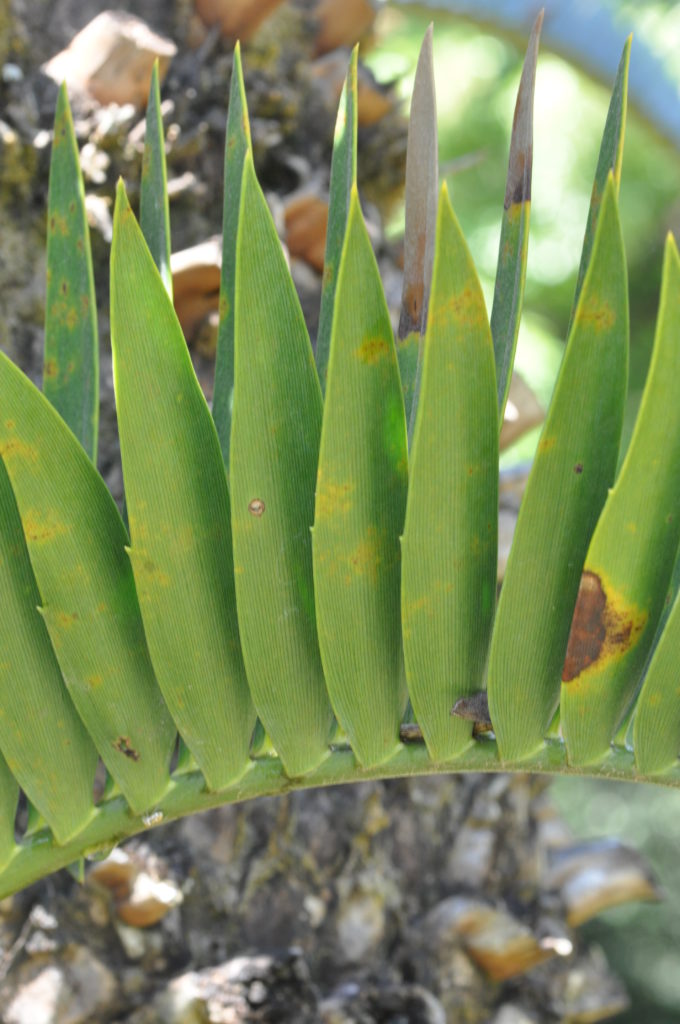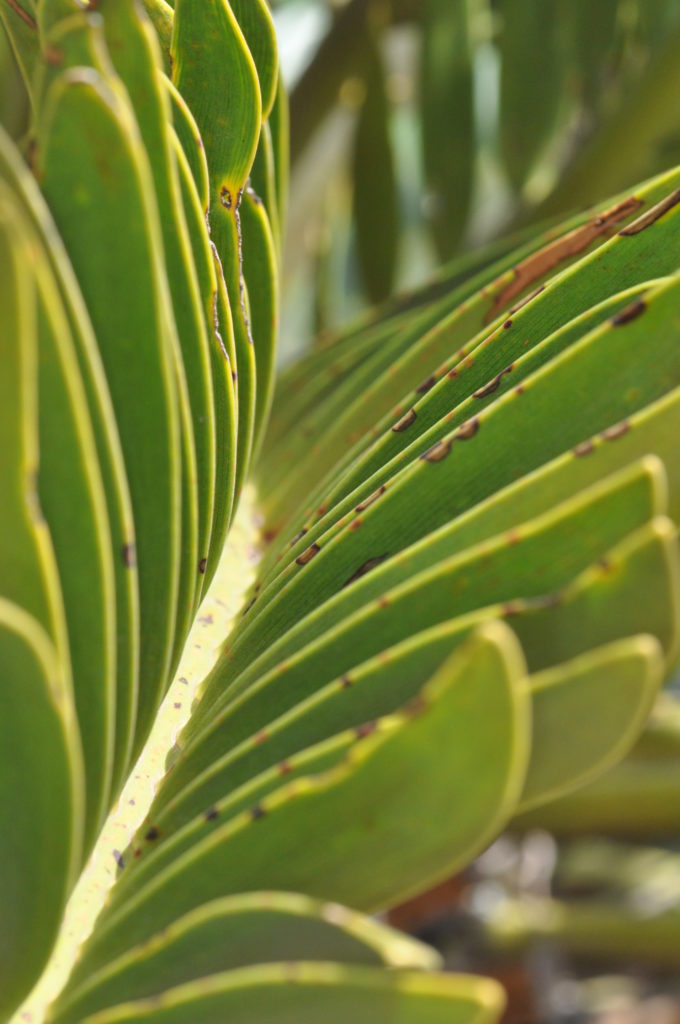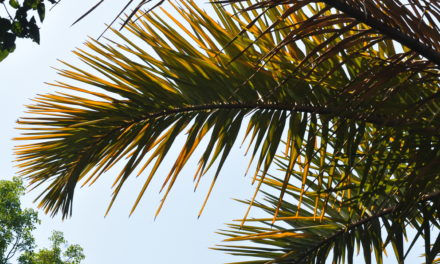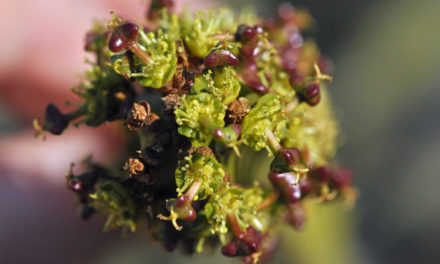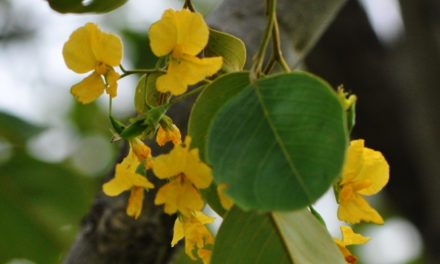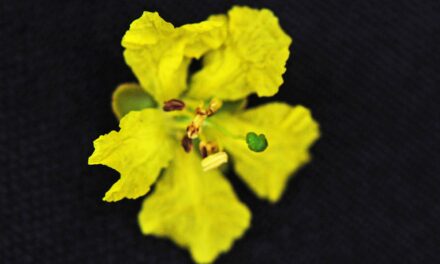General Info – summary
This dioecious Tree trunk is up to 4m x 45cm and has distinct leaf scars. Pinnately compound Leaves with a yellow rachis are up to 2m long. Leaflets have parallel veins, lack a midrib and the petioles do fall – after the leaf blades. The lowest leaflets are reduced to prickles. Beetles effect pollination. Male Cones produce motile sperm. Female Cones are massive – up to 36kg. The large red seeds are poisonous.
Description
Encephalartos longifolius
Previous Name: Zamia longifolia.
SA Tree No. 9.
Common names: (Afr) Suurberg-broodboom, Broodboom. (Eng) Bread Palm, Suurberg Cycad, Breadpalm, Thunberg’s Cycad. Suurberg Mountains in the Eastern Cape run east to west and are attached to the eastern end of the Cape Fold Belt.
Family: Zamiaceae. This family is part of the major group: Gymnosperms. Zamiaceae are usually cone-bearing plants producing naked seeds and include Ginkgo (in China), Cycads, Conifers (e.g., pine trees) and Gnetophytes: e.g., the unique Welwitschia mirabilis (tweeblaarkanniedood) are not wind pollinated and found in the deserts of western Namibia and southern Angola. Members of the gymnosperm family Zamiaceae have no flowers or fruit and the seeds are often contained in Cones. This family has 8 genera, including the Genus Encephalartos, which contains all species of cycads.
Name derivation: Encephalartos: within-head-bread: referring to the starchy bread that can be made from the pith of the inner trunk. longifolius: with long leaves.
The African plants in the genus Encephalartos include about 66 species and 35+ species occur in southern Africa.
Conservation: National Status: N T (Near Threatened). Assessed: 2009 (J. S. Donaldson). This is mainly due to illegal collecting. More than 10 locations remain.
Tree
Species of Encephalartos (Cycads) are only superficially palm or fern like and the Trunk is usually unbranched. This Tree has an almost erect, seldom branched trunk (photo 927) up to 4m high. The trunk diameter is often thick (up to 45cm in diameter) with a very large pith. Once the entire leaves fall, only leaf scars remain on the trunk (photo 895). The cycad tap Root is usually replaced early by lateral roots, which become woody. Many stems can arise from the base.
- Photo 891: David Becking.
- Photo 891: David Becking.
- Photo 927: David Becking.
- Photo 895: David Becking.
Leaves
Cycads are unique Gymnosperms with evergreen, pinnately compound Leaves (leaflets are arranged along either side of the leaf rachis, the central stalk, like a feather). Unlike other members of the family Zamiaceae, the cycads have leaflets that lack a central Midrib (vein). The hard leaflets do not bend easily, and the veins are parallel. Stomata (structure utilising 2 guard cells that, unlike lenticels, can control gaseous exchange) are present on the lower surface and may occur above.
In this tree, the light young leaves are only initially hairy. Mature leaves are dark or metallic, slightly glossy green, often with a grey bloom and are up to 2m long. The bright yellow Rachis (main axis bearing flowers or leaflets – photo 930 & 928) arches especially towards the end. The Petioles (leaf bases) remain on the tree for a short while after the leaf blades have fallen (photo 930). Once the petiole has fallen, only a Leaf Scar remains (photo 895 under Tree). The persistent leaves last for 3-4 years. The broad lanceolate Leaflets are up to 20 x 4cm. The leaflets usually overlap slightly, or are slightly spaced apart. They are arranged upwards in a V-formation (photo 929). The leaflet Apex may be sharp tipped (photo 894) or rounded (photo 929). The Margin is usually entire (with a continuous margin, not in any way indented) but some prickles may appear on the leaflet margins (photo 894). The leaflets decrease in size towards the base where they may be reduced to 1 or 2 prickles (photo 930).
- Photo 930: David Becking.
- Photo 894: David Becking.
- Photo 929: David Becking.
Cones
All cycads are Dioecious with male and female Cones developing on separate plants. Cones develop in the centre of the leaf whorls. Male cycads produce Motile Sperm, which do not move along a pollen tube. At maturity, Seeds are released when the Female cones disintegrate. All seeds produce carcinogenic and neurotoxic glycosides (cycasins). These are poisonous to mammals including man. All Gymnosperms have unenclosed or naked seeds. They have no flowers or fruit and the seeds are often contained in cones. In the Angiosperms (flowering plants), the seeds are enclosed in an ovary. In the Gymnosperms, there are 2 modes of fertilization. In all the Cycads (including Encephalartos) and the single extant (not extinct) species of Ginkgo biloba, the male cones produce motile sperm. The remaining members of the Gymnosperms all have non-motile sperm with no flagella that are moved along with a Pollen tube to the egg.
In Encephalartos longifolius there are up to 3 greenish-brown Male cones which are almost cylindrical and may reach 60 x 20cm. Usually, 1 ovoid Female cone with naked ovules is produced. Each olive green cone is enormous, up to 60 x 40cm and among the largest and heaviest of the cycads – certainly the heaviest in the South Africa, with a mass of up to up to 36kg. This tree is insect pollinated and beetles (Coleoptera) have been identified as the most common pollinators of cycads. Monkeys and baboons aid the dispersal the seeds. (Apr-Jun). The bright red Seeds are about 5 x 2,5cm.
Distribution & Ecology
Cycads have Coralloid Roots that contain symbiotic cyanobacteria (blue-green algae) that fix atmospheric nitrogen. Through a process of complex biological pathways, the cyanobacteria convert atmospheric molecular nitrogen into compounds such as ammonia, and amino acids needed by the cycads. Encephalartos longifolius is Endemic (endemism is the ecological state of a species being unique to a defined geographic location) in the South Africa and was first recorded in 1772. These trees are usually found on steep rocky slopes and dense thickets in Fynbos (a belt of natural shrubland or heathland in the winter rainfall area with the distinctive vegetation of the Western Cape). Trees can be found in the Suurberg Mountains (about 70km long W-E situated NE of False Bay). They are also found in the Eastern Cape up to an altitude of 1 500m e.g., near Grahamstown and near Van Staden’s Flower reserve (40km west of Port Elizabeth). These trees are very slow growing and can survive in areas where annual rainfall varies between 300 to 1 200mm. This and Encephalartos lehmannii occur further west than most cycads. Encephalartos longifolius may hybridise with Encephalartos horridus. Rodents, monkeys baboons as well as birds – like hornbills disperse the Seeds. These birds consume the outer covering and discard (disperse) the poisonous seeds. (Oct-Dec).
Ethnobotany
Encephalartos longifolius was the first cycad seen by early, eastward moving colonists. It resembles the now extinct Zamites recta from the lower Cretaceous period – 145 million to about 100 million years ago – during the breakup of Gondwanaland. Seeds are Poisonous. General Smuts and others in his commando were nearly killed by eating the seeds of this plant during the Anglo Boer War (1982-1902). Seeds are the main method of propagation. N.B. wear gloves when handling any cycad seeds. For seed production, both male and female plants are required, and this is difficult to determine before cones develop. One of these plants, with a caudex (stem) of 13cm, sold in the USA for about $800 in 2019.
References
Coates Palgrave, M. 2002. Keith Coates Palgrave Trees of Southern Africa. edn 3. Struik, Cape Town.
Donaldson, J.S. 2009. Encephalartos longifolius (Jacq.) Lehm. National Assessment: Red List of South African Plants version 2020.1. Accessed on 2023/04/16.
Lawrence, G. H. M, 1951. Taxonomy of Vascular Plants. The Macmillan Company, New York. Tenth Printing 1965.
Palmer, E. & Pitman, N. 1972. Trees of southern Africa. Balkema, Amsterdam, Cape Town.
http://www.plantzafrica.com/plantefg/voteplant.php
https://en.wikipedia.org/wiki/Encephalartos_longifolius
http://www.cycadpalm.com/enloblfo.html
http://cycadsociety.org/?page_id=1810
http://pza.sanbi.org/encephalartos-longifolius
http://biodiversityadvisor.sanbi.org/wp-content/uploads/sanbi-identify-it/plants/encephalartos.htm
http://www.theplantlist.org/browse/G/Zamiaceae/
https://www.diffen.com/difference/Angiosperms_vs_Gymnosperms
https://en.wikipedia.org/wiki/Suurberg

